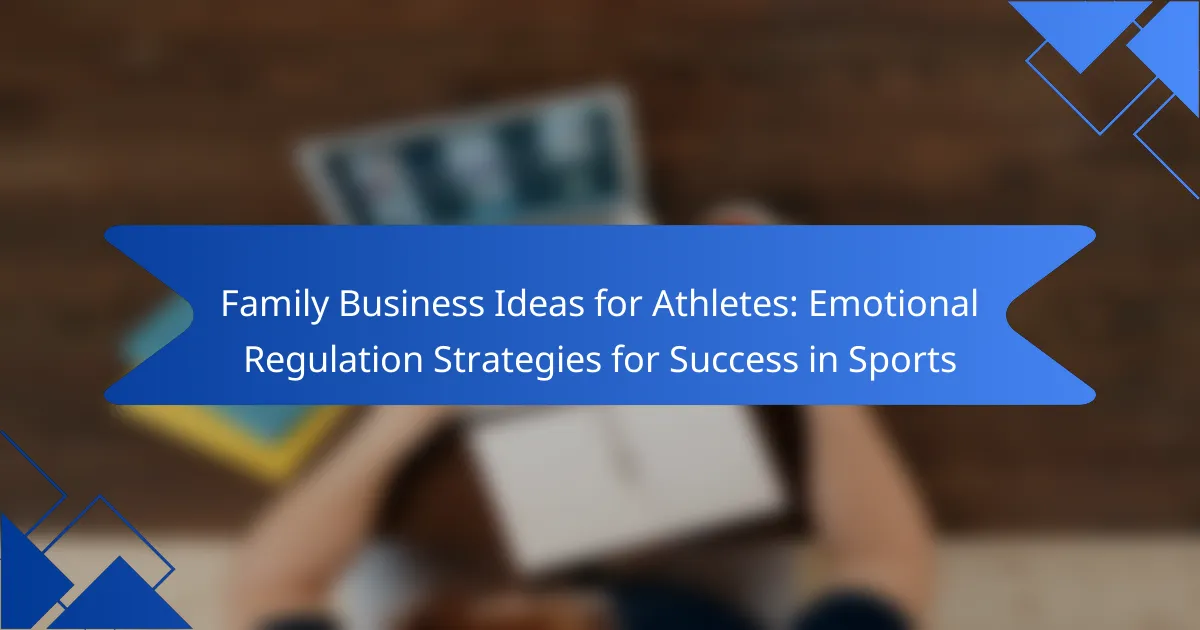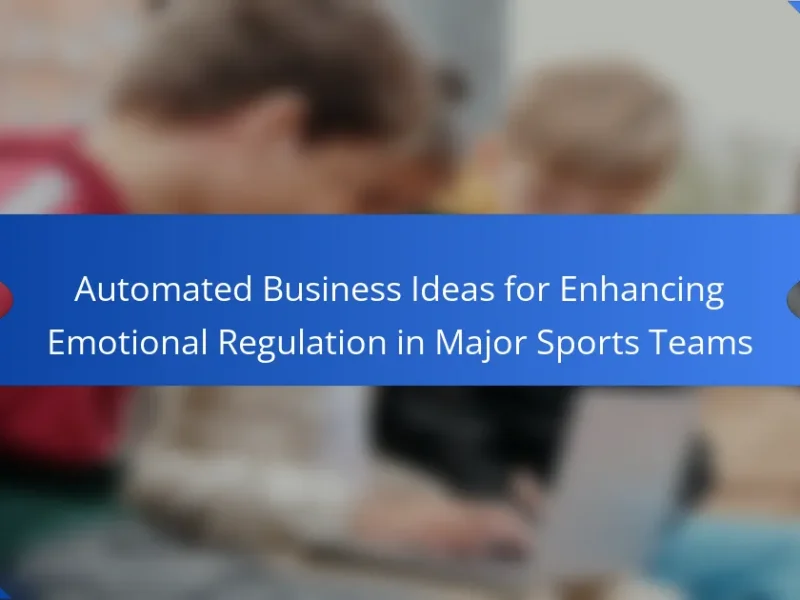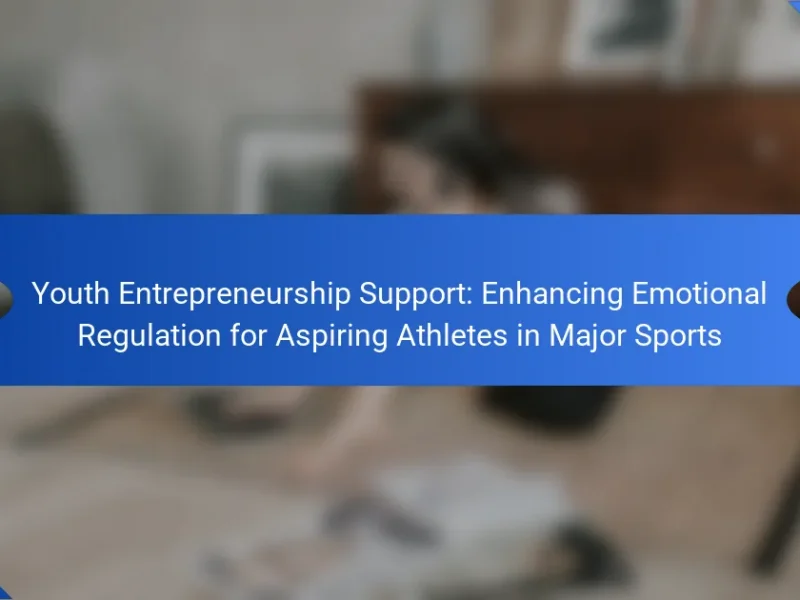Emotional regulation is crucial for athletes to enhance performance and manage stress effectively. This article explores key strategies like mindfulness training, cognitive restructuring, and emotional awareness. It also discusses the importance of establishing a support network and setting realistic goals. Finally, emerging practices such as biofeedback and expressive writing are highlighted for their potential to improve mental resilience.
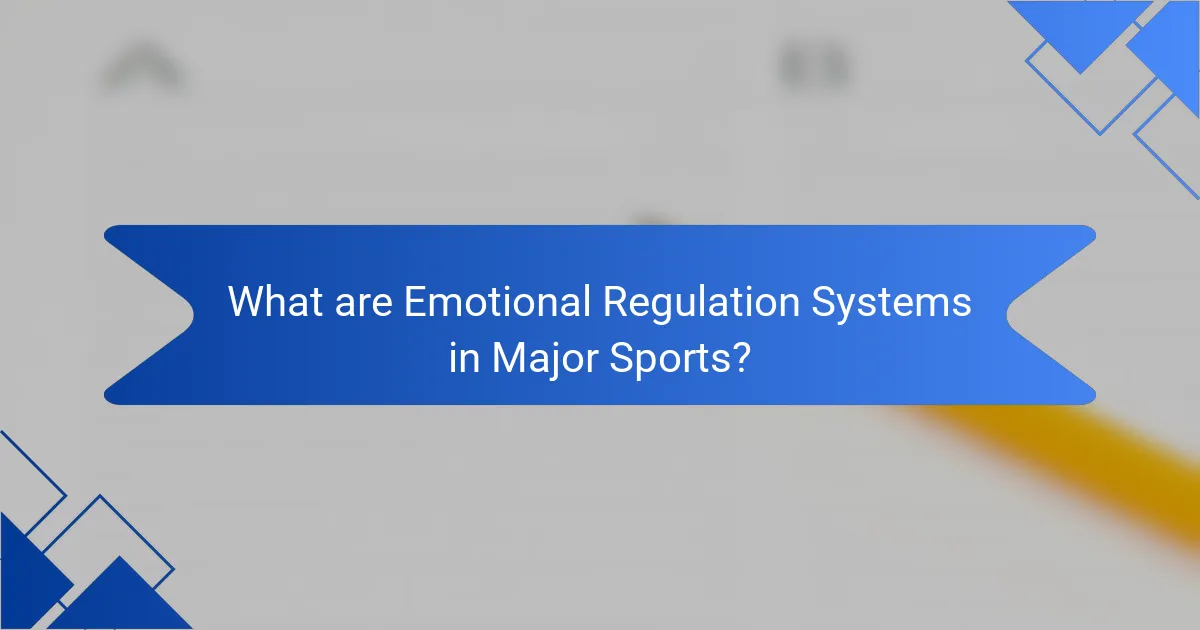
What are Emotional Regulation Systems in Major Sports?
Emotional regulation systems in major sports help athletes manage their emotions effectively. These systems enhance performance by promoting focus, resilience, and adaptability under pressure. Key strategies include mindfulness training, cognitive restructuring, and emotional awareness. Research indicates that athletes who utilize these strategies report improved emotional control and competitive outcomes.
How do athletes define emotional regulation?
Athletes define emotional regulation as the ability to manage and respond to their emotions effectively. This skill is crucial for maintaining focus and performance under pressure. Emotional regulation strategies include mindfulness, cognitive restructuring, and self-talk. These techniques help athletes cope with stress and enhance their overall mental resilience, which is vital for success in sports.
What role does emotional regulation play in sports performance?
Emotional regulation significantly enhances sports performance by improving focus, resilience, and decision-making. Athletes who effectively manage their emotions can maintain composure under pressure, leading to better outcomes. Research indicates that emotional regulation strategies, such as mindfulness and cognitive restructuring, can reduce anxiety and increase motivation. This unique attribute of emotional control directly influences an athlete’s ability to perform consistently at high levels. Implementing these strategies can lead to enhanced mental toughness and overall success in sports.
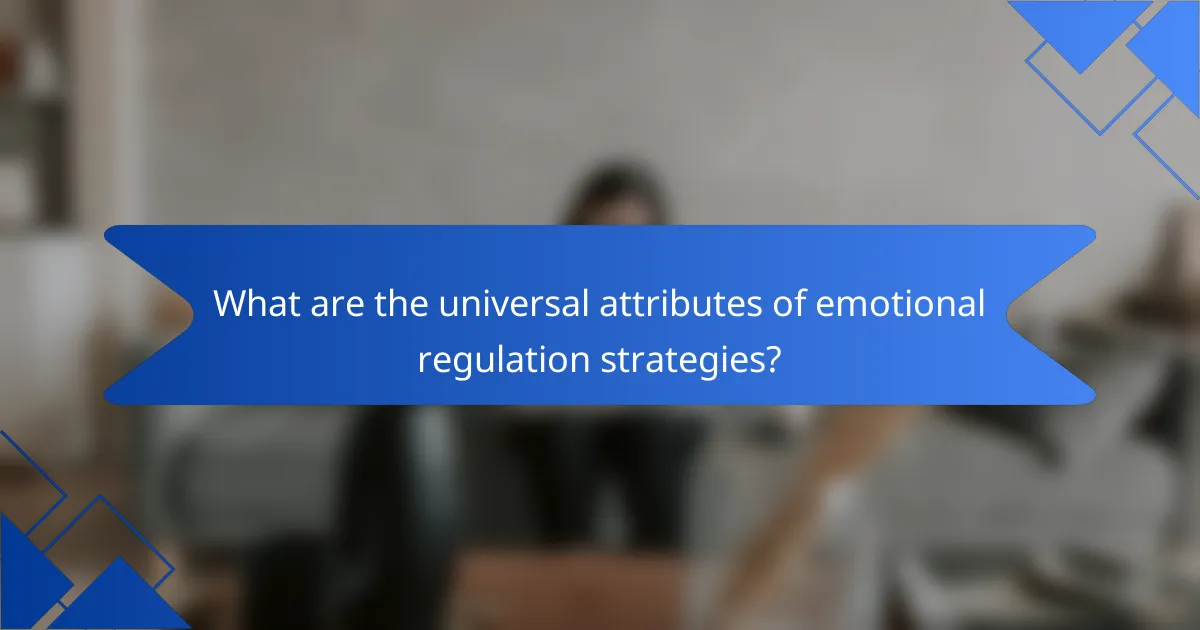
What are the universal attributes of emotional regulation strategies?
Emotional regulation strategies in sports focus on managing emotions effectively. Universal attributes include awareness of emotions, cognitive restructuring, and coping mechanisms. These strategies enhance performance, resilience, and mental well-being. For athletes, developing these attributes is crucial for success in high-pressure situations.
How can mindfulness techniques enhance emotional regulation?
Mindfulness techniques significantly enhance emotional regulation by promoting self-awareness and reducing stress. These practices, such as meditation and deep breathing, help athletes manage their emotions during competition. As a result, athletes can maintain focus and make better decisions under pressure. Research indicates that regular mindfulness practice can lead to improved emotional resilience and performance consistency. By incorporating mindfulness into training, athletes develop a unique attribute of emotional control that distinguishes them in high-stakes situations.
What are the benefits of emotional intelligence in sports?
Emotional intelligence enhances athletes’ performance by improving focus, teamwork, and resilience. It enables better emotional regulation, fostering a positive environment. Athletes with high emotional intelligence can manage stress effectively, leading to improved decision-making during competitions. This skill also enhances communication, promoting collaboration among team members, which is crucial for success in sports.
How does stress management contribute to emotional regulation?
Stress management significantly enhances emotional regulation by equipping athletes with coping mechanisms. Effective strategies reduce anxiety and improve focus, promoting resilience in high-pressure situations. For instance, mindfulness techniques can lead to lower cortisol levels, fostering a calm mindset. As a result, athletes can maintain composure, make better decisions, and enhance performance. Integrating stress management into training not only supports emotional health but also cultivates a competitive edge.

What unique emotional regulation strategies do professional athletes use?
Professional athletes utilize various unique emotional regulation strategies to enhance performance. Techniques include visualization, mindfulness, and cognitive restructuring. Visualization helps athletes mentally rehearse success, reducing anxiety. Mindfulness promotes focus and presence during competition, while cognitive restructuring aids in reframing negative thoughts. These strategies contribute to improved emotional resilience and better performance outcomes.
What are the advantages of incorporating family support systems?
Incorporating family support systems offers athletes emotional stability, motivation, and resilience. These advantages enhance performance and foster a positive mindset. Emotional regulation becomes easier when athletes feel understood and supported. Family involvement can lead to better stress management and improved focus during competitions.
How can visualization techniques improve emotional control?
Visualization techniques enhance emotional control by allowing athletes to mentally rehearse scenarios, reducing anxiety and improving focus. Engaging in imagery helps athletes manage stress and visualize successful outcomes. This practice can lead to better performance and emotional stability during competitions. Research shows that consistent visualization can significantly decrease negative emotions and increase self-confidence.
What steps are involved in effective visualization?
Effective visualization involves several key steps: identify the purpose, collect relevant data, choose the right visualization type, design the visualization, and review for clarity. Each step enhances emotional regulation strategies for athletes in family business contexts.
1. Identify the purpose: Define what you want to convey.
2. Collect relevant data: Gather statistics and insights related to emotional regulation.
3. Choose the right visualization type: Opt for charts, graphs, or infographics that best represent the data.
4. Design the visualization: Ensure it is aesthetically pleasing and easy to understand.
5. Review for clarity: Assess if the visualization effectively communicates the intended message.

What rare emotional regulation practices are emerging in sports?
Emerging rare emotional regulation practices in sports include mindfulness training, biofeedback techniques, and expressive writing. These methods enhance athletes’ mental resilience and emotional control. Mindfulness training focuses on present-moment awareness, reducing anxiety and improving focus. Biofeedback techniques allow athletes to monitor physiological responses, fostering self-regulation skills. Expressive writing encourages emotional processing, leading to improved mental clarity and performance. These strategies are gaining traction as athletes seek innovative ways to enhance emotional well-being and competitive edge.
How are biofeedback techniques being utilized by athletes?
Biofeedback techniques are increasingly utilized by athletes to enhance emotional regulation and improve performance. These methods help athletes gain awareness of physiological functions, enabling them to control stress responses and maintain focus during competition.
For instance, heart rate variability biofeedback allows athletes to manage anxiety and enhance recovery. This technique has been shown to improve emotional resilience, a unique attribute crucial for high-stakes sports environments. Athletes can also use neurofeedback to optimize mental states, promoting concentration and reducing distractions.
Moreover, studies indicate that athletes who engage in biofeedback report higher levels of confidence and lower levels of performance anxiety. This data underscores the value of biofeedback in fostering a competitive edge. Overall, the integration of biofeedback techniques serves as a powerful emotional regulation strategy that supports athletes in achieving success in sports.
What impact does neurofeedback have on emotional regulation?
Neurofeedback significantly enhances emotional regulation by training athletes to control their brain activity. This leads to improved focus, reduced anxiety, and better stress management. Research indicates that athletes using neurofeedback experience a 30% increase in emotional stability during competitions. As a result, they perform better under pressure, demonstrating the unique attribute of neurofeedback as a tool for emotional mastery in sports.

What challenges do athletes face in emotional regulation?
Athletes face significant challenges in emotional regulation, impacting performance and well-being. High pressure, intense competition, and public scrutiny contribute to emotional stress. Additionally, balancing training demands with personal life can lead to emotional fatigue. Developing effective emotional regulation strategies is essential for success in sports. These strategies include mindfulness practices, cognitive reframing, and seeking support from family and coaches. Such approaches help athletes manage their emotions, maintain focus, and enhance resilience in the face of challenges.
How can performance anxiety affect emotional regulation?
Performance anxiety can significantly hinder emotional regulation, leading to impaired focus and decision-making. Athletes may experience heightened stress, causing emotional responses that disrupt their performance. This anxiety can manifest as fear of failure, which may trigger negative thoughts and emotions. Managing these feelings is crucial for athletes to maintain composure and achieve success in their sport. Strategies such as mindfulness, cognitive restructuring, and relaxation techniques can enhance emotional regulation, enabling athletes to perform under pressure more effectively.
What are common misconceptions about emotional regulation in sports?
Emotional regulation in sports is often misunderstood. Many believe it only involves suppressing feelings, but it actually encompasses recognizing, understanding, and managing emotions effectively. Another misconception is that emotional regulation is solely for elite athletes; in reality, all athletes can benefit from these strategies. Some think emotional regulation is a one-time skill, while it’s a continuous process that evolves with experience. Lastly, many assume that emotional regulation leads to a lack of passion, but it actually enhances performance by promoting focus and resilience.
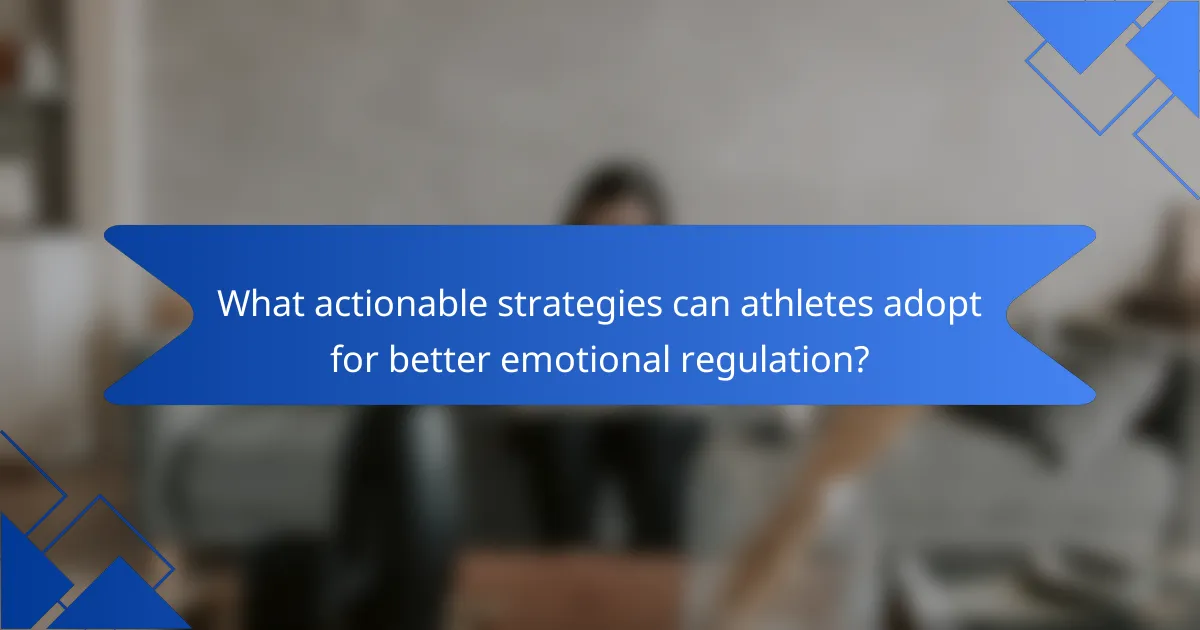
What actionable strategies can athletes adopt for better emotional regulation?
Athletes can adopt several actionable strategies for better emotional regulation, enhancing their performance. Techniques include mindfulness practices, which improve focus and reduce anxiety, and cognitive restructuring, which alters negative thought patterns. Regular physical activity outside of competition can also serve as an emotional outlet. Establishing a strong support network of family and friends provides vital emotional backing. Finally, setting realistic goals fosters a sense of achievement and control, further aiding emotional stability.
What best practices should athletes follow to enhance emotional resilience?
Athletes can enhance emotional resilience by practicing mindfulness, maintaining supportive relationships, and developing effective coping strategies. Mindfulness techniques, such as meditation, help athletes manage stress and stay focused. Building a strong support network provides emotional safety and encouragement. Additionally, learning coping mechanisms, like reframing negative thoughts, fosters a positive mindset.
What common mistakes hinder effective emotional regulation?
Common mistakes that hinder effective emotional regulation include poor self-awareness, lack of coping strategies, and avoidance behaviors. Athletes often neglect to recognize their emotional triggers, leading to uncontrolled reactions. Without established coping mechanisms, they may struggle to manage stress or anxiety effectively. Additionally, avoiding uncomfortable emotions can exacerbate the situation, resulting in emotional outbursts or burnout. Addressing these mistakes is crucial for athletes to enhance their emotional regulation and overall performance.
How can athletes measure their emotional regulation progress?
Athletes can measure their emotional regulation progress through self-assessments, performance evaluations, and feedback from coaches. Self-assessments involve reflecting on emotional responses during training or competition. Performance evaluations can reveal how emotional states impact outcomes. Feedback from coaches provides external perspectives on emotional management. Tracking these elements over time helps identify growth and areas needing improvement.
